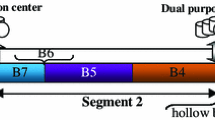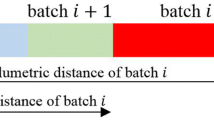Abstract
This paper addresses the problem of developing an optimization model to aid the operational scheduling in a real-world pipeline scenario. The pipeline connects refinery and harbor, conveying different types of commodities (gasoline, diesel, kerosene, etc.). An optimization model was developed to determine pipeline scheduling with improved efficiency. This model combines constraint logic programming (CLP) and mixed integer linear programming (MILP) in a CLP-MILP approach. The proposed model uses decomposition strategies, continuous time representation, intervals that indicate time constraints (time windows), and a series of operational issues, such as the seasonal and hourly cost of electric energy (on-peak demand hours). Real cases were solved in a matter of seconds. The computational results have demonstrated that the model is able to define new operational points to the pipeline, providing significant cost savings. Indeed the CLP-MILP model is an efficient tool to aid operational decision-making within this real-world pipeline scenario.
Similar content being viewed by others
References
Buscemi, M. G., & Montanari, U. (2008). A survey of constraint-based programming paradigms. Computer Science Review, 2, 137–141.
Cafaro, D. C., & Cerdá, J. (2004). Optimal scheduling of multiproduct pipeline systems using a non-discrete MILP formulation. Computers and Chemical Engineering, 28, 2053–2068.
COPEL Companhia Paranaense de Energia (Paranaense’s Company of Energy) (2009). Tax and tariffs of energy, on-line information available at http://www.copel.com in January 2009.
Dantzig, G. B. (1963). Linear programming and extensions. Princeton: Princeton University Press.
Floudas, C. A. (1995). Nonlinear and mixed integer optimization: fundamentals and applications. New York: Oxford University Press.
Gomes, C. P., & Shmoys, D. (2002). The promise of LP to boost CSP techniques for combinatorial problems. In Fourth international workshop on integration of AI and OR techniques in constraint programming for combinatorial optimization problems, Le Croisic, France (pp. 291–305).
Heipcke, S. (1999). Combined modelling and problem solving in mathematical programming and constraint programming. Ph.D. thesis, University of Buckingham, UK.
Hooker, J. N. (2000) Wiley–Interscience Series in discrete mathematics and optimization. Logic-based methods for optimization: combining optimization and constraint satisfaction. New York: Wiley–Interscience.
Hooker, J. N. (2006). An integrated method for planning and scheduling to minimize tardiness. Constraints, 11, 139–157.
Hürlimann, T. (1998). An efficient logic-to-IP translation procedure. In International conference, applied mathematical programming and modeling, Lymassol, Cyprus (pp. 1–26).
ILOG (2002a). ILOG OPL studio 3.6.1—user’s manual, ILOG Corporation, France.
ILOG (2002b). ILOG OPL studio 3.6.1—language manual, ILOG Corporation, France.
Kalvelagen, E. (2003). On solving the progressive party problem as a MIP. Computers & Operations Research, 30(11), 1713–1726.
Kennedy, J. L. (1993). Oil and gas pipeline fundamentals. Oklahoma: PennWell Publishing Company.
Lee, H., Pinto, J. M., Grossman, I. E., & Park, S. (1996). Mixed-integer linear programming model for refinery short-term scheduling of crude oil unloading with inventory management. Industrial and Engineering Chemistry Research, 35, 1630–1641.
Magatão, L. (2005). Constraint logic programming and mixed integer linear programming: towards a unified modeling framework. Ph.D. thesis, Graduate School in Electrical Engineering and Industrial Computer Science (CPGEI), Federal University of Technology—Paraná (UTFPR), Curitiba, Paraná, Brazil.
Magatão, L., Arruda, L. V. R., & Neves, F. Jr (2004). A mixed integer programming approach for scheduling commodities in a pipeline. Computers and Chemical Engineering, 28(1–2), 171–185.
Mitra, G., Lucas, C., Moody, S., & Hadjiconstantinou, E. (1994). Tools for reformulating logical forms into zero-one mixed integer programs. European Journal of Operational Research, 72, 262–276.
Moura, A. V., Souza, C. C., Cire, A. A., & Lopes, T. M. T. (2008). Planning and scheduling the operation of a very large oil pipeline network. In P. J. Stuckey (Ed.), LNCS : Vol. 5202. Proceedings of CP 2008 (pp. 36–51). Berlin: Springer.
Neiro, S. M. S., & Pinto, J. M. (2004). A general modeling framework for the operational planning of petroleum supply chains. Computers and Chemical Engineering, 28, 871–896.
Neves-Jr, F., Arruda, L. V. R., Magatão, L., Stebel, S. L., Boschetto, S. N., Felizari, L. C., Czaikowski, D. I., Rocha, R., & Ribas, P. C. (2007). An efficient approach to the operational scheduling of a real-world pipeline network. In Computer aided chemical engineering : Vol. 24. Proceedings of 17th European symposium on computer aided process engineering (ESCAPE 17) (pp. 697–702). Bucareste, 2007. Amsterdam: Elsevier.
Pettersson, M. P., Szymanek, R., & Kuchcinski, K. (2007). A CP-LP approach to network management in OSPF routing. In Proceedings of the 2007 ACM symposium on applied computing (pp. 311–315). Seoul, Korea.
Régin, J. C. (1994). A filtering algorithm for constraints of difference in CSPs. In Proceedings of the twelfth national conference on artificial intelligence (AAAI’94) (pp. 362–367). Seattle, Washington, United States, 1.
Rejowski, R. Jr., & Pinto, J. M. (2004). Efficient MILP formulations and valid cuts for multiproduct pipeline scheduling. Computers and Chemical Engineering, 28, 1511–1528.
Rejowski, R. Jr., & Pinto, J. M. (2008). A novel continuous time representation for the scheduling of pipeline systems with pumping yield rate constraints. Computers and Chemical Engineering, 32, 1042–1066.
Reklaitis, G. V. (1992). Overview of scheduling and planning of batch process operations. In Proceedings of the NATO advanced study institute on batch processing systems (pp. 660–705). Antalya, Turkey.
Relvas, S., Matos, H. A., Barbosa-Póvoa, A. P. F. D., Fialho, J., & Pinheiro, A. S. (2006). Pipeline scheduling and inventory management of a multiproduct distribution oil system. Industrial and Engineering Chemistry Research, 45, 7841–7855.
Relvas, S., Matos, H. A., Barbosa-Póvoa, A. P. F. D., & Fialho, J. (2007). Reactive scheduling framework for a multiproduct pipeline with inventory management. Industrial and Engineering Chemistry Research, 46, 5659–5672.
Rossi, F. (2003). Constraint processing. Constraint logic programming. (pp. 413–440). San Francisco: Morgan Kaufmann. ISBN 978-1-55-860890-0.
Rossi, F., Beek, P., & Walsh, T. (2006). Handbook of constraint programming. Foundations of artificial intelligence. New York: Elsevier. ISBN 0444527265.
Schrage, L. (2000). Optimization modeling with LINGO. Chicago: LINDO Systems Inc.
Simonis, H. (2008). Constraint logic programming. Orsay: COSYTEC SA.
Subrahmanyam, S., Bassett, M. H., Pekny, J. F., & Reklaitis, G. V. (1995). Issues in solving large scale planning, design and scheduling problems in batch chemical plants. Computers and Chemical Engineering, 19(suppl.), 577–582.
Van Hentenryck, P., Perron, L., & Puget, J. F. (2000). Search and strategies in OPL. ACM Transactions on Computational Logic, 1, 285–320.
Wallace, M. (2007). Constraint programming—the paradigm to watch. Constraint Programming Letters, 1, 7–13.
Williams, H. P. (1995). Logic applied to integer programming and integer programming applied to logic. European Journal of Operational Research, 81, 605–616.
Williams, H. P., & Wilson, J. M. (1998). Connections between integer linear programming and constraint logic programming—an overview and introduction to the cluster of articles. INFORMS Journal on Computing, 10(3), 261–264.
Wu, D., & Ierapetritou, M. G. (2003). Decomposition approaches for the efficient solution of short-term scheduling problems. Computers and Chemical Engineering, 27, 1261–1276.
Author information
Authors and Affiliations
Corresponding author
Rights and permissions
About this article
Cite this article
Magatão, L., Arruda, L.V.R. & Neves-Jr, F. A combined CLP-MILP approach for scheduling commodities in a pipeline. J Sched 14, 57–87 (2011). https://doi.org/10.1007/s10951-010-0186-9
Published:
Issue Date:
DOI: https://doi.org/10.1007/s10951-010-0186-9




